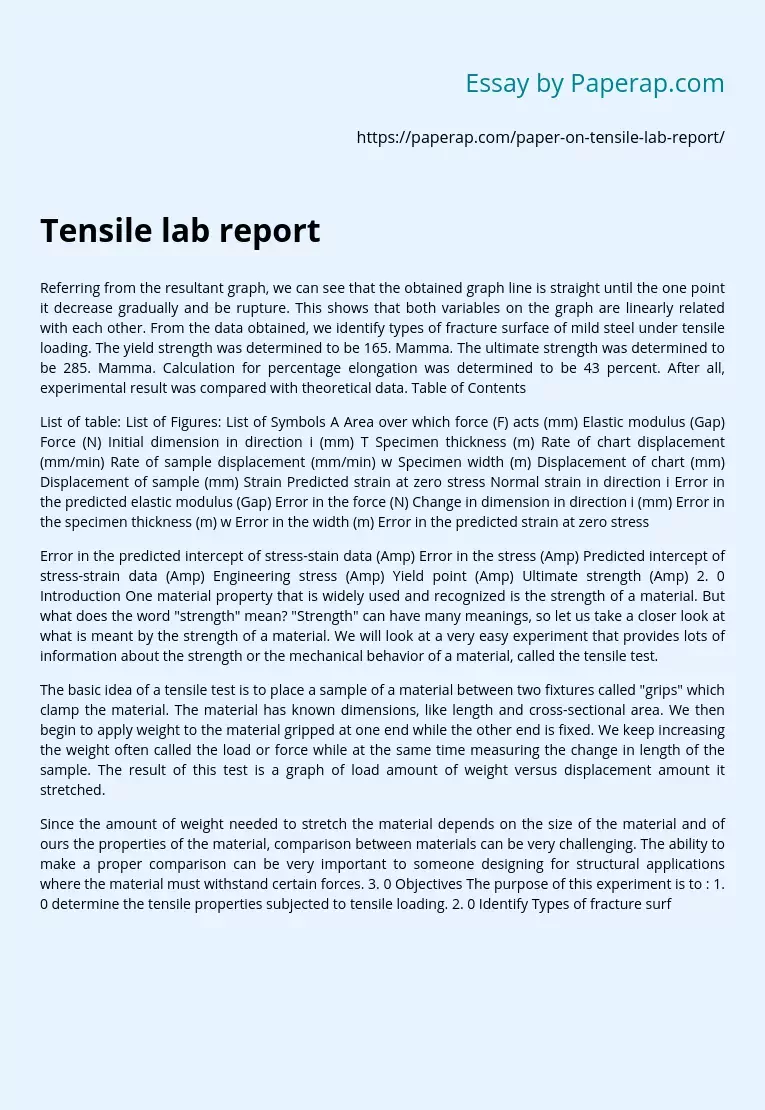Tensile lab report
Referring from the resultant graph, we can see that the obtained graph line is straight until the one point it decrease gradually and be rupture. This shows that both variables on the graph are linearly related with each other. From the data obtained, we identify types of fracture surface of mild steel under tensile loading. The yield strength was determined to be 165. Mamma. The ultimate strength was determined to be 285. Mamma. Calculation for percentage elongation was determined to be 43 percent. After all, experimental result was compared with theoretical data.
Table of Contents
List of table: List of Figures: List of Symbols A Area over which force (F) acts (mm) Elastic modulus (Gap) Force (N) Initial dimension in direction i (mm) T Specimen thickness (m) Rate of chart displacement (mm/min) Rate of sample displacement (mm/min) w Specimen width (m) Displacement of chart (mm) Displacement of sample (mm) Strain Predicted strain at zero stress Normal strain in direction i Error in the predicted elastic modulus (Gap) Error in the force (N) Change in dimension in direction i (mm) Error in the specimen thickness (m) w Error in the width (m) Error in the predicted strain at zero stress
Error in the predicted intercept of stress-stain data (Amp) Error in the stress (Amp) Predicted intercept of stress-strain data (Amp) Engineering stress (Amp) Yield point (Amp) Ultimate strength (Amp) 2.
0 Introduction One material property that is widely used and recognized is the strength of a material.
But what does the word “strength” mean? “Strength” can have many meanings, so let us take a closer look at what is meant by the strength of a material. We will look at a very easy experiment that provides lots of information about the strength or the mechanical behavior of a material, called the tensile test.
The basic idea of a tensile test is to place a sample of a material between two fixtures called “grips” which clamp the material. The material has known dimensions, like length and cross-sectional area. We then begin to apply weight to the material gripped at one end while the other end is fixed. We keep increasing the weight often called the load or force while at the same time measuring the change in length of the sample. The result of this test is a graph of load amount of weight versus displacement amount it stretched.
Since the amount of weight needed to stretch the material depends on the size of the material and of ours the properties of the material, comparison between materials can be very challenging. The ability to make a proper comparison can be very important to someone designing for structural applications where the material must withstand certain forces. 3. 0 Objectives The purpose of this experiment is to : 1. 0 determine the tensile properties subjected to tensile loading. 2. 0 Identify Types of fracture surface under tensile loading. 3. 0 Validate the data between experimental and theoretical values. . 0 Theory Certain materials which are linear, homogeneous, elastic, and isotropic can be scribed by their material properties. These properties include the modulus of elasticity, ultimate tensile strength, modulus of toughness, modulus of resilience and yield strength. Assuming mild steel is homogeneous material, tensile testing had been carried out. One of important fundamental material Science is tensile testing which is carried out by applying inguinal stress on the subject until it fracture such below. When force are applied to materials, it deform in reaction to those forces.
This inguinal stress also known as tensile stress is given by a formula of: While normal strain is given by: In theory, properties of material include the modulus of elasticity, modulus of toughness, modulus of resilience, ultimate tensile strength, and yield strength applied to all instances of that material undergoing the same type of stress, allowing one to design structural elements whose behavior can be predicted but in at early stage of tested material will elongate to show elastic behavior as the apply stress is proportional to the strain and Hooker’s law is obeyed.
Hence this formula came: Elastic modulus, E also can be determine from Stress-strain graph which act as the gradient from the initial to limit of proportionality. As stress increasing, elastic behavior stop at their elastic limit and entering plastic deformation. Since many metals lack a sharp yields points, i. E a sudden, observable transition between the elastic region and the plastic region, the yields points is often defined as the stress that gives rise to a 0. 2% permanent plastic strain. By this convention, a line is drawn parallel to the elastic region of the materials, starting at a strain level of 0. % strain. The point at which this line intersects the curve is called the yield point or yield stress. The ultimate tensile strength( stress), in entrant is found by determining the maximum stress, reached by the materials. The ductility of the material can be measured most accurately from the tensile test using this definition: This measure of ductility is closely related to one based upon the change in gage length divided by the original gage length, but after fracture the gage length is difficult to measure Tensile testing is very important because the performance of materials are a matter of life or death.
Tensile lab report. (2018, Aug 02). Retrieved from https://paperap.com/paper-on-tensile-lab-report/

